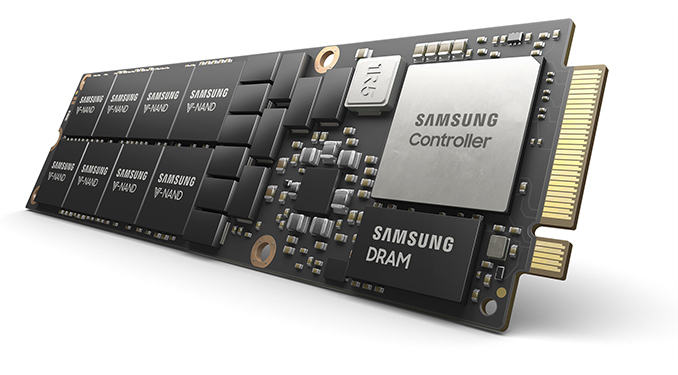Samsung Kicks Off Mass Production of 8 TB NF1 SSDs with PCIe 3.0 x4 Interface [updated]
by Anton Shilov on June 21, 2018 9:00 AM EST
Samsung this week announced that it had started mass production of its new 8 TB NF1 SSDs. Samsung has been demonstrating prototype NF1 SSDs for slightly less than a year now, so it is not surprising that some of its customers are now ready to adopt them. The larger NF1 form factor allows for drives with double the capacity of M.2 SSDs, and they are aimed primarily at data-intensive analytics and virtualization applications that require higher performance and capacity than what M.2 can provide.
Update 6/22: Samsung made an update to its statements regarding the NF1 SSDs. The drives are based on the Phoenix controller, they do not use a PCIe 4.0 interface, but rely on a more traditional PCIe Gen 3 x4 interface.
Samsung’s NF1 SSDs are based on the company’s 512 GB packages comprising of 16 layers of 256 Gb TLC V-NAND memory devices, as well as the company’s proprietary controller accompanied by 12 GB of LPDDR4 memory. Prototype NF1 drives used Samsung’s Phoenix controllers already used for client SSDs, early on Friday the company confirmed that the commercial NF1 SSDs are indeed the PM983 SSDs powered by the Phoenix controller. From performance point of view, the NF1 drives deliver sequential read speeds of 3100 MB/s and write speeds of 2000 MB/s. When it comes to random performance, the drives are capable of up to 500K read IOPS as well as 50K write IOPS. As for endurance, Samsung rates the drives for 1.3 DWPD.
| Samsung NF1 (PM983) SSD Specification | |||
| Capacity | 8 TB | ||
| Controller | Phoenix | ||
| NAND Flash | 256 Gb TLC V-NAND | ||
| Form-Factor, Interface | NF1, PCIe 3.0 x4 | ||
| Sequential Read | 3100 MB/s | ||
| Sequential Write | 2000 MB/s | ||
| Random Read IOPS | 500K IOPS | ||
| Random Write IOPS | 50K IOPS | ||
| Pseudo-SLC Caching | unknown, likely not | ||
| DRAM Buffer | 12 GB LPDDR4 | ||
| TCG Opal Encryption | No | ||
| Power Consumption | Active | Read | ? W |
| Write | ? W | ||
| Idle | ? mW | ||
| Warranty | 3 years | ||
| MTBF | 2 million hours | ||
| TBW | 11388 TB | ||
| Price | ? | ||
Two interesting points that Samsung mentioned in its press release was the fact that its NF1 SSDs enabled an undisclosed maker of servers to install 72 of such drives in a 2U rack for a 576 TB capacity and the fact that the drives used a PCIe 4 interface, a claim that was later retracted. All previous public demonstrations of NF1 SSDs were carried out on 1U servers based on Intel’s Xeon processors and there is also an NF1-compatible server from AIC based on AMD’s EPYC CPU. Samsung’s customer who uses the NF1 drives will likely identify itself in the coming months. In the meantime, the only shipping processor supporting PCIe 4 is the IBM POWER9, whereas the only PCIe 4-supporting switches are available from Microsemi. As for the 2U machine featuring 72 NF1 bays, it has not been publically announced yet.
Samsung promises to start producing higher-capacity NF1 SSDs later this year. The company also says that JEDEC is expected to formally standardize the NF1 (aka NGSFF) spec this October.
Update 07/05: Samsung has sent out an oddly timed correction some 2 weeks after the initial announcement, essentially disowning their comments on when NF1 is expected to be standardized. However their new statement also doesn't state that their estimate was incorrect, merely that they shouldn't have made it.
"Samsung in a footnote to its NF1 announcement unintentionally exceeded its jurisdiction in estimating a possible time frame for completion of the JEDEC Next-generation Small Form Factor (NGSFF) standard. We regret the oversight."
Related Reading:
Source: Samsung











21 Comments
View All Comments
PeachNCream - Thursday, June 21, 2018 - link
Mass production was so kicked off that Samsung is using CGI renders of products instead of photographs.jordanclock - Thursday, June 21, 2018 - link
Would it make a difference? Renders are better for marketing. They can fit more "Samsung" logos on all the parts.PeachNCream - Thursday, June 21, 2018 - link
It's sort of like buying a cucumber at a grocery store. It's nice to be able to touch/poke/caress said cucumber before stuffing it in...your cart...to buy it.FullmetalTitan - Thursday, June 21, 2018 - link
Realistically they just want to hide component details for the DRAM package and controller until clients have these in hand for a bit of use.edzieba - Thursday, June 21, 2018 - link
Assuming the proposed NGSFF spec is adopted, NGSFF is backward compatible with m.2 electrically and physically in terms of the connector itself (drive dimensions are wider and a little thicket than m.2 2210). Though these drives will probably be outside the price-range of anyone using m.2 on desktop.Santoval - Friday, March 15, 2019 - link
Wait, NGSFF/NF1 employs the M.2 connector but is *thicker*? How is that possible? I get the "wider" part (which is self-explanatory from the renders) but how can it be thicker and backwards compatible? Does the PCB have the same thickness but the total thickness (for dies, capacitors etc) is relaxed compared to M.2?iwod - Thursday, June 21, 2018 - link
I was rather hoping we get 6GB/s + with PCI-E 4jordanclock - Thursday, June 21, 2018 - link
The interface isn't the bottleneck, the NAND+controller is.Gothmoth - Thursday, June 21, 2018 - link
but it has 12 GB buffer... so at least for a second or two it should have higher max burst speed.shabby - Thursday, June 21, 2018 - link
Its and evo 970 under the hood.